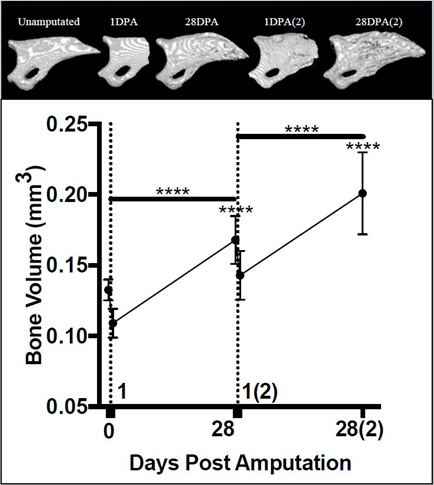Blast-related combat injuries can lead to significant tissue loss (such as from burns or volumetric muscle loss injuries) or amputation in Service members. Regenerative medicine seeks to promote healing by supporting the body’s innate pathways of repair and regrowth, but much is unknown about these processes. Mice and humans are able to regenerate finger and toe tips, providing a paradigm to study complex tissue regrowth.
Researchers from Texas A&M University compared the anatomy of normal and regenerated digit tips using mice (Dolan et al., 2019). Amputation of the digit tip removed bone, connective tissue, skin, nails, vasculature, and the parts of nerve cells that end in the connective tissue but did not remove bone marrow or the nerve cells that terminate there. The digit tip was allowed to regrow for 28 days at which point it was considered regenerated. Compared to the original digit tip, the regenerated tip had more diverse types of nerve cells ending in the bone marrow and fewer nerves ending in the connective tissue. There were still fewer nerves ending in the connective tissue of the regenerated tip 120 days after amputation than in the original tip, suggesting nerve regrowth was impaired, not just delayed.
To assess bone regeneration, the researchers measured the bone volume of normal, amputated, and regenerated digit tips (Figure 1, TOP). Twenty-eight days after amputation, the bone volume of the regenerated digit tip was actually greater than it was before amputation. Interestingly, the bone volume was greater still after the regenerated tip was amputated and allowed to regrow for 28 days a second time (Figure 1, BOTTOM). Considering these results with the observed nerve anatomy, the data suggest that a reduced number of nerves in the connective tissue does not limit bone regeneration in the digit tip.
Studies like this one, which characterize the normal regenerative response to severe injury, provide critical foundational knowledge for the development of regenerative medicine approaches. Such advanced therapies could one day help to restore form and function to Service members injured in combat.

Dolan CP, Yan M, Zimmel K, Yang TJ, Leininger E, Dawson LA, Muneoka K. Axonal regrowth is impaired during digit tip regeneration in mice. Developmental Biology. 2019;445(2):237-244.
Your 15 minute session will timeout in approximately 10 minutes.
If you're in the middle of entering information, please close this warning and save your progress (if possible) or finish up your task.
If your session fully times out, you will lose any un-saved work.
Your current Blast Injury Research Program session has expired.
Your next click will take you away from the private area, and you will lose any work you have in-progress.
Please enter your email address, and try again.